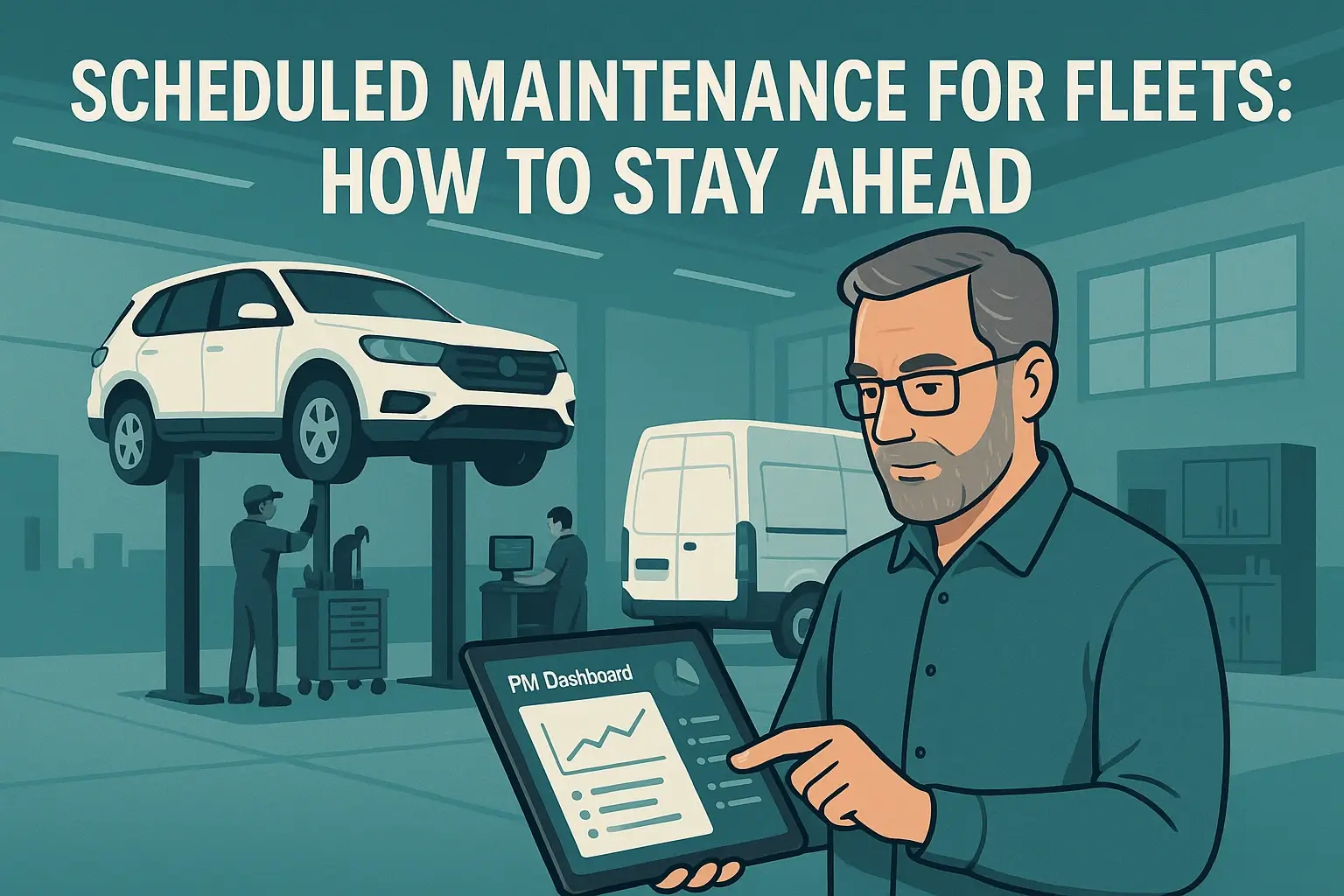Key Takeaways
As a logistics company, your fleet is the backbone of your operations. Whether you’re transporting goods across cities or delivering them right to your customer’s doorstep, maintaining your fleet is essential. You already know that even a single vehicle breakdown can disrupt your schedule, frustrate customers, and inflate costs. That’s why proactive fleet maintenance is key to ensuring smooth operations, keeping costs in check, and maintaining your company’s reputation.
.avif)
If you're feeling the pressure of balancing operational efficiency with vehicle upkeep, you're not alone. Many logistics companies face similar challenges, but the good news is that by adopting a few key fleet maintenance best practices, you can reduce downtime, keep vehicles running efficiently, and improve overall profitability. Let’s explore the fleet maintenance strategies you can start using today.
1. Develop a Regular Maintenance Schedule
One of the biggest mistakes you can make is waiting for something to go wrong before servicing your vehicles. Reactive maintenance is not only costly but also highly disruptive to your logistics operations. Instead, you should have a regular maintenance schedule in place.
This schedule ensures that routine checks and services are performed at the right time, preventing major issues from arising in the first place.
You can create a maintenance schedule based on factors like:
- Mileage: Every vehicle has specific mileage intervals for maintenance activities like oil changes, tire rotations, and brake inspections.
- Time-based servicing: If your vehicles don’t accumulate high mileage quickly, then a time-based schedule, such as every six months, can ensure that maintenance isn’t overlooked.
- Usage patterns: Vehicles used more frequently or under harsher conditions (like heavy loads or rough terrains) need more frequent attention.
By sticking to a schedule, you not only reduce the chances of unexpected breakdowns but also extend the lifespan of your vehicles. This means fewer replacements and more savings over time.
2. Prioritize Preventive Maintenance
You’ve probably heard the phrase, “Prevention is better than cure.” That couldn’t be truer when it comes to fleet maintenance. Preventive maintenance is about identifying and fixing minor issues before they turn into costly repairs. This doesn’t just save you money—it helps you avoid the headache of vehicle downtime and the potential delays that could impact your customer relationships.
Preventive maintenance tasks might include:
- Regular oil changes
- Brake inspections
- Tire rotations
- Fluid checks and top-ups (e.g., coolant, brake fluid, transmission fluid)
By performing these tasks regularly, you’re actively working to prevent bigger problems, like engine failure or brake malfunctions. Your drivers will thank you, too—they’ll feel safer and more confident knowing they’re operating well-maintained vehicles.
3. Conduct Routine Inspections
In the hustle and bustle of managing a fleet, it’s easy to overlook the importance of regular vehicle inspections. But routine inspections are your first line of defense in catching potential issues before they become expensive problems.
Your drivers should conduct pre-trip inspections to check for things like:
- Tire pressure and tread wear
- Brake functionality
- Fluid levels (oil, coolant, etc.)
- Lights and signals
- Wiper blades and windshield clarity
If something seems off, it’s better to address it immediately than risk a breakdown on the road. You can even incorporate electronic inspection tools (like mobile apps) that allow drivers to log issues in real time. This ensures that you’re constantly aware of the health of your fleet.
4. Keep Detailed Maintenance Records
A mistake many logistics companies make is not keeping accurate and detailed maintenance records for each vehicle. Proper record-keeping allows you to track how often a vehicle has been serviced, what repairs were made, and what parts were replaced.
These records are crucial for several reasons:
- They help you spot trends, like a vehicle that’s consistently needing repairs, signaling it may be time for replacement.
- They ensure you’re complying with regulatory requirements, avoiding potential fines or legal issues.
- They assist in resale value. When you have proof that a vehicle has been well-maintained, it’s easier to sell or trade in for a higher price.
You don’t need to rely on paper records, either. Fleet management software can make it easier to track maintenance schedules, log inspections, and access service histories with a few clicks. This way, you’ll never have to wonder when the last time a vehicle was serviced.
Download Your Free Fleet Maintenance Checklist
5. Use Fleet Maintenance Software
Technology is your best friend when it comes to managing a large fleet. Fleet maintenance software allows you to automate many of the processes that are essential for keeping your vehicles in good condition.
These systems can:
- Send reminders for upcoming maintenance tasks.
- Track fuel consumption and vehicle usage.
- Monitor real-time performance metrics, such as engine health or tire pressure.
- Log driver inspection reports and maintenance activities.
Using software doesn’t just simplify the maintenance process; it also helps you identify inefficiencies. For example, if you notice that certain vehicles are consuming more fuel than expected, you can investigate the cause, such as poor maintenance or inefficient driving practices.
6. Train Your Drivers
Your drivers are on the front line of your fleet, so it’s essential that they’re well-trained in basic vehicle maintenance and safety checks. Training your drivers to conduct pre-trip inspections, report issues promptly, and drive responsibly can significantly reduce wear and tear on your fleet.
Encouraging your drivers to report even small issues can save you from bigger repairs down the line. Additionally, safe driving practices—like avoiding harsh braking, rapid acceleration, or overloading vehicles—help maintain the health of your fleet.
7. Monitor Fuel Efficiency
For logistics companies, fuel is one of the biggest operational costs. Poorly maintained vehicles use more fuel, which directly impacts your bottom line. Regular maintenance helps ensure that your fleet is running efficiently, reducing fuel consumption. Keeping tires properly inflated, ensuring engines are tuned, and replacing air filters regularly are simple steps that make a big difference.
You can also use fleet management software to track fuel usage. If you notice that certain vehicles are using more fuel than others, it may be time for a more thorough inspection to identify the cause.
8. Plan for Seasonal Maintenance
Different weather conditions impact vehicles in various ways. For example, in colder months, vehicles may need special attention, such as:
- Switching to winter tires
- Inspecting and replacing worn-out wiper blades
- Ensuring the battery is functioning properly
- Using the appropriate type of engine oil for colder temperatures
By preparing for seasonal changes, you reduce the risk of breakdowns caused by harsh weather conditions and keep your fleet running smoothly, no matter the season.
Related Posts
- Fleet Insights for the Transportation and Logistics Industry
- 9 Reasons Why You Should Have Fleet Management Software in the Logistics Sector
- 7 Ways Digital Transformation is Improving Logistics
Keep Your Fleet Running Smoothly with Simply Fleet
Maintaining a fleet is no small task, but by implementing these best practices, you’ll find that you can keep your vehicles running efficiently, reduce costly downtime, and improve your company’s overall performance. A well-maintained fleet keeps your customers happy, your drivers safe, and your bottom line healthy. Start incorporating these practices into your operations today, and watch your fleet (and business) thrive.
Simply Fleet's Fleet Maintenance Software offers a simple, intuitive platform to help you schedule regular maintenance, track repairs, and monitor vehicle health in real-time. Reduce downtime, prevent costly breakdowns, and improve fuel efficiency—all from one dashboard. With Simply Fleet, you'll stay on top of your fleet’s needs, ensuring compliance and maximizing the lifespan of your vehicles. Take control of your fleet today with Simply Fleet’s trusted maintenance solution.



.png)








.png)


.png)
.avif)





